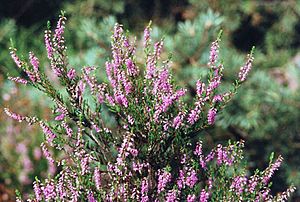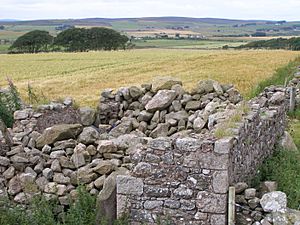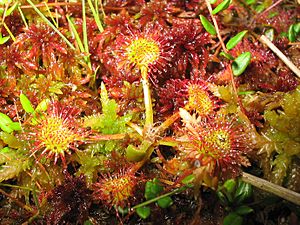Portlethen Moss facts for kids
The Portlethen Moss is a special nature reserve located west of Portlethen, a town in Aberdeenshire, Scotland. It's an acidic bog, which is a type of wetland that supports many different plants and animals. Even though the area has seen some building and farming nearby, it remains an important home for wildlife. For example, the Great crested newt used to live here before the town grew bigger. Many plants that like acidic soil grow in Portlethen Moss. The Scottish Wildlife Trust helps to look after this important habitat.
Portlethen Moss has a rich history, going back to prehistoric times, the Middle Ages, and even the 1600s. This is mainly because a ridge near the bog was a common route for early travelers. By the Middle Ages, this trackway was built more formally with raised stones and was known as the Causey Mounth. Without this special road, it would have been impossible to travel through Portlethen Moss and other nearby bogs between Aberdeen and the coast to the south.
Contents
History of the Moss

People lived around Portlethen Moss a very long time ago, even in the Iron Age. We know this from stone circles and other old items found nearby. Only the higher, rocky areas would have been suitable for living. But being close to the sea and having the moss as a natural defense against enemies made it a good place to settle.
The Roman general Agricola found it hard to cross Portlethen Moss and other local bogs, according to old writings by Tacitus. This is also why the Roman Camp of Raedykes was built just south of these bogs. The Romans couldn't go further north, so they turned inland towards Netherley. Portlethen Moss is also close to the Grampian Mountains.
The old Causey Mounth road connected the Bridge of Dee to the town of Stonehaven. This route was used in 1638 AD by the Covenanters, a group who met at Muchalls Castle to oppose the Bishops of Aberdeen. It was also the path taken by William Keith, 7th Earl Marischal and James Graham, 1st Marquess of Montrose. They led a Covenanter army of 9000 men in a big battle during the Bishops' Wars in 1639.
East of Portlethen Moss are three old fishing villages: Findon, Portlethen Village, and Downies. From 1960 to 2005, Portlethen grew into a town where many people live and travel to Aberdeen for work. It also became a place with large superstores.
Protecting the Moss
The Scottish Wildlife Trust (with the code PLM076) and the Aberdeenshire Council officially recognize Portlethen Moss as a nature preserve. In ancient times, people used to cut peat from the moss. Peat is decayed plant matter that can be used as fuel. However, no peat has been cut in modern times.
Today, some parts of the moss are still affected by cattle grazing. But the biggest problem is the ongoing building of new homes and businesses. In fact, half of Portlethen Moss was lost to new buildings in Portlethen between 1985 and 2005. People walking on the moss don't cause much damage because there aren't many visitors. Also, cattle grazing is less of a threat than the town's continued growth. The addition of animal manure from grazing animals is also not a big problem because there aren't many animals.
Overall, the Scottish Wildlife Trust believes that the original moss has been greatly damaged. The special "raised bog" habitat of Portlethen Moss is also protected by the United Kingdom Biodiversity Action Plan. This plan helps protect important natural areas.
Land and Weather
Portlethen Moss is known as a "raised bog" because it sits on higher ground. It's located at the edge of the Mounth, which is a coastal mountain range connected to the Grampian Mountains. From here, you can see the North Sea. You can also find rocky areas and large boulders left over from the Ice Age.
The land within Portlethen Moss is about 35 to 60 meters (115 to 197 feet) above sea level. This moss formed because of many dips and hollows in the Old Red Sandstone rocks below. All the water in the bog comes from rain and snow. There's no water flowing into it from rivers or streams, as the land slopes downwards in every direction.
The area has strong winds, moderate rain, and cool temperatures. These conditions are perfect for an acid bog to form. Water stays still, but it eventually evaporates, making the decaying plants more acidic. In ancient times, there was almost no way for water to drain out, and even today, there's very little drainage.
How Portlethen Moss Grew
Many coastal mosses started forming because of glaciers. Glaciers smoothed out the land and also dug out medium-sized holes that would fill with water. This is how Portlethen Moss began. Over thousands of years, sphagnum moss grew a lot. As water evaporated, the soil acidity increased, fed by decaying plants. There was also very little drainage.
A layer of sphagnum moss grew at the bottom of the bog. More sphagnum layers floated on top, forming mats. Over time, thick layers of peat formed from the decayed and carbonized sphagnum. Different types of plants like Carex (sedges) and Juncus (rushes) also grew and decayed, adding to the organic material.
Eventually, other plants started to grow in the spongy sphagnum mats, making the bog even bigger. Sometimes, these heavy, waterlogged layers of organic material could even break open. This would spill large amounts of mud and plant debris into the surrounding fields, allowing the bog to spread even further. Eventually, the water in the moss turned a blood-red color because of all the decaying plants and still water. Only when cattle grazed or many people were present (probably in the late Iron Age) did this process slow down, and the bog shrink in size.
Plants of the Moss

Portlethen Moss is home to many different types of sphagnum moss, sedges, rushes, and other plants typical of bogs. Sometimes, insect-eating plants live in mosses because the soil doesn't have many nutrients. The heath also provides food for local roe deer. A plant called Corydalis claviculata is a favorite host for many butterfly larvae.
Here are some of the plants you can find in this nature reserve:
- Agrostis canina, velvet bentgrass
- Anthoxanthum odoratum
- Arrhenatherum elatius, tall meadow oat grass
- Aulacomnium palustre
- Betula pubescens, downy birch
- Calluna vulgaris, true heather
- Cardamine amara, large bittercress
- Carex curta
- Carex demissa
- Carex echinata, Murray sedge
- Cirsium arvense, creeping thistle
- Corydalis claviculata
- Dactylis glomerata, cocksfoot grass
- Dactylorhiza maculata
- Deschampsia flexuosa, tussock grass
- Dicranum scoparium
- Drosera rotundifolia, English sundew (insectivorous)
- Dryopteris dilatata, broad buckler fern
- Epilobium palustre
- Erica tetralix, cross leaved heath
- Eriophorum vaginatum, cotton grass
- Festuca ovina, sheep's fescue
- Hypnum cupressiforme
- Juncus bulbosus
- Neottia cordata, a rare plant
- Potentilla palustris
- Salix cinerea
- Sphagnum capillifolium
- Sphagnum squarrosum
- Ulex europaeus
- Urtica dioica, stinging nettle
- Viola palustris, marsh violet
Other Scottish Mosses
Scotland has many "mosses" or bog habitats. Many of them are in Aberdeenshire, just like Portlethen Moss. Some nearby examples include the Cookney Moss, Leuchar Moss, and Red Moss of Netherley. Other areas in Scotland like Fife, Angus, Morayshire, and Lanarkshire also have mosses. Some of these are lowland bogs, while others, like Portlethen Moss, are raised bogs. Similar acidic peat bogs can be found in northern North America, Russia, and northern Europe. In those places, they are usually just called "bogs."



